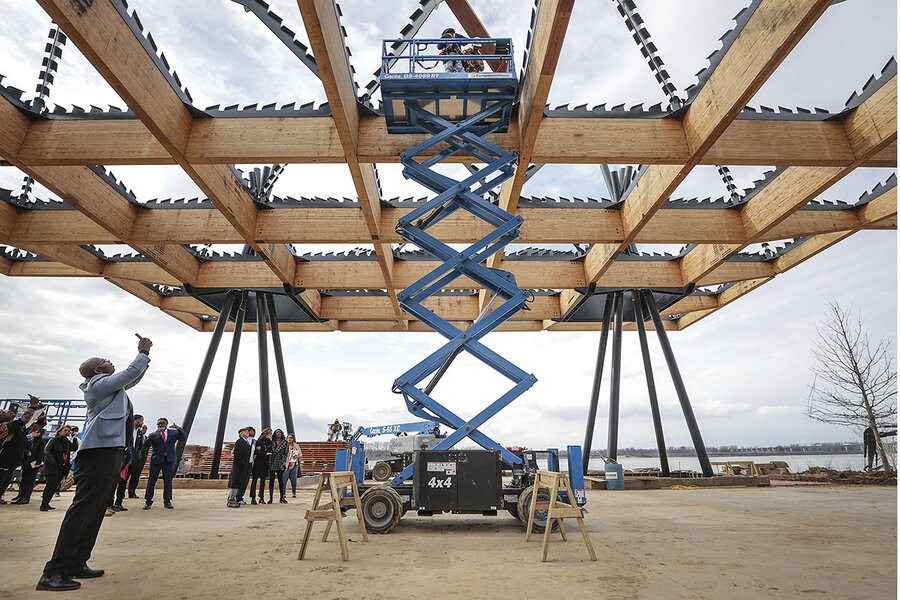In aftermath of Tyre Nichols, Memphis seeks to rewrite its story
Loading...
| Memphis, Tennessee
Last January in his State of the City address, Memphis Mayor Jim Strickland walked to the lectern with a binder of good news.
The city was still in a swell of violent crime, but it was also investing in youth programs and its police force – including an elite SCORPION unit. The city had lost 46,000 jobs during the pandemic, but almost all of them were now recovered. Mayor Strickland titled the speech “A City on the Rise.”
A year later to the day, Mr. Strickland addressed the city again, this time in a video preparing them for footage of five police officers ruthlessly beating Tyre Nichols. His coda: “We must all work to regain the public’s trust and work together to heal the wounds these events have caused.”
Why We Wrote This
A story focused onTyre Nichols’ death seemed only to confirm a portrait of Memphis as defined by crime and poverty. But in all their city’s contradictions, Memphians see something else, too: promise.
This is a familiar cycle in Memphis – adding new wounds before the city’s old ones fully heal. Its residents often speak of their home as a series of contradictions: liberation and poverty, racial progress and stagnation, nonviolent protest and persistent violent crime. Mr. Nichols’ death would have been traumatic anywhere, but in Memphis it met a local crisis of confidence.
“We have such potential,” says Tomeka Hart Wigginton, former commissioner of Memphis City Schools and the Memphis Urban League. “But I’ve got to tell you, we’ve been saying that for 30 years.”
In the aftermath of Mr. Nichols’ death and the release of the police footage, many residents sensed the return of that same reputation they’ve tried so long to eschew: a caricature of poverty and violence, a city that can’t be saved.
Memphians often argue for their city’s promise as though they’re repeating a liturgy. This is, after all, the home of the blues, the birthplace of Elvis, a global distribution hub, a lodestone of American history. How is that so different, they say, from Atlanta or St. Louis?
And that, perhaps, is the core contradiction of Memphis. Its residents often have to make peace with their city, its high rates of poverty and crime, and its many setbacks. But they also harbor a sense of pride. Memphis may be wandering in the wilderness, but Memphians still believe it can be the promised land.
Roots in history
For much of the city’s history, its advantages enabled its worst faults. Its progress always excited backlash.
The nearby Mississippi River and the city’s fertile ground made Memphis one of the capitals of the South’s cotton kingdom, and by 1850, it was the world’s largest inland market for cotton and for slave labor. The size of the Black population also made Memphis a haven for people escaping slavery, looking to blend in and then flee upriver.
During the Jim Crow era, Memphis had a relatively prosperous Black population – including America’s first Black millionaire. At the same time, the city and surrounding Shelby County also had Tennessee’s most recorded lynchings.
Decades later, in 1968, the city saw the assassination of Martin Luther King Jr. on the balcony of the Lorraine Motel, after asking a musician to play his favorite hymn. King’s death accelerated a deal to improve conditions for the striking sanitation workers he came to Memphis to support.
“We have never really gotten over that,” says Otis Sanford, a veteran city journalist and historian. “It opened up so many other wounds and created so many other problems.”
One of those problems was that many of the city’s white residents and businesses began to flee, fearing unrest and eventual integration. The mostly white city gradually became less so, and by the 1990 census, African Americans made up a majority.
At just under 65%, Memphis’ share of Black residents is one of the highest among major American cities. “With that has come for a long time a lot of Black political power,” says Ms. Hart Wigginton, and yet “not nearly enough Black economic power.”
The city’s overall poverty rate is 22.6%, and that of Black residents is 26.5%. Explaining why – like the recital of Memphis’ strengths – summons a list of the city’s weaknesses: poor education, sclerotic local government, and, atop everyone’s mind, violent crime.
“It is the number one challenge that we face,” says Bill Gibbons, former district attorney and head of the Memphis Shelby Crime Commission.
The crime narrative
Even as crime has fallen overall in the past five years, Memphis’ rate of violent crime has soared. The police department reported 302 homicides last year, 44 fewer than in 2021 but far more than in the mid-2010s.
Elevated cameras known as SkyCops now shine dark blue lights above the city’s business districts. Local news stations flash crime alerts and reports of shootings on their broadcasts. Residents end conversations telling each other to “stay safe.”
“I worry about the fact that seemingly random acts of violence, however they unfold, are becoming normalized and that we unintentionally build some callousness around them,” says Russell Wigginton, head of the National Civil Rights Museum and husband of Ms. Hart Wigginton.
At the same time, says Dr. Wigginton, it’s hard to find another large – especially Southern – city without its share of crime. Those cities, unlike Memphis, aren’t primarily known for their violence, something he, like many other Memphians, attributes to race.
“If we were not a majority-Black city, we would not have that reputation,” says Dr. Wigginton.
Reputation aside, violent crime remains both an issue that citizens desperately want to solve and the epitome of an unsolvable problem, especially in a city that’s struggled with violence since the 1800s. The demand to do so inexorably leads back to tough-on-crime policing and, often, the specter of police violence.
“The vast majority of citizens, especially African Americans, want more of a police presence in their neighborhoods,” says Mr. Gibbons, sitting in his cluttered office beside former police director Buddy Chapman. “Having said that, they also want good policing.”
Many Memphians don’t think policing gives them that option. Mr. Chapman, now head of Memphis’ tip line CrimeStoppers, rose to the top of the department soon after the police beating of another young Black man, named Elton Hayes, 50 years ago. Community trust in the department, he says, was fragile before Mr. Nichols’ death. It’s fractured now.
The city’s crime “is definitely a problem,” says Mr. Chapman. “But you don’t solve it by having your police officers violate the law.”
A big small town
The sum of these parts is a city that often feels like it’s wasting its own potential.
“We’re stuck,” says Ms. Hart Wigginton. “I feel like we’re constantly stuck.”
Despite that feeling, something always brings her back to this city. As the old joke goes, Memphis is a small town with a lot of people living in it.
“Everything that any company, any family would need is in this community,” says Ms. Hart Wigginton.
After the murder of George Floyd in 2020, the National Civil Rights Museum didn’t have to light a beacon for people to gather. On their own, says Connie Dyson of the museum, just under 10,000 peaceful protesters gathered at the old Lorraine Motel, where a wreath hangs from the balcony on room 306.
“People come here. They’re drawn here. ... They find comfort here,” says Dr. Wigginton, speaking at the museum’s offices across the street. Typical Memphis, he says, choosing the place of most acute pain as the place to find closure.
Protesters didn’t gather the same way following the death of Tyre Nichols, a fact he attributes to the city leaders’ decision to fire and prosecute the officers. Such peaceful response is also a part of the city’s identity. When King died in 1968, Memphis’ response was relatively calm.
“We have this unbelievable persevering spirit about ourselves,” says Dr. Wigginton. “The overwhelming majority of the time, that’s to our favor. But part of what it covers up is our vulnerability and the need to heal.”
“Grit n’ grind”
The city’s unofficial motto comes from its basketball team, the Grizzlies, whose logo sits on Dr. Wigginton’s notebook: “Grit n’ Grind.” The challenge is not to grow exhausted by the grind.
Randy Gamble, part of the city’s Lynching Sites Project, seeks that balance daily. Mr. Gamble and his team have spent the last seven years researching, documenting, and memorializing victims of lynching in the city. “You have to have love to do this work,” he says. “Because if not, it’s going to literally drive you crazy.”
In early 2016, back when the project had just begun, Mr. Gamble parked at a nearby miniature golf course with two white colleagues and walked into the woods, searching for the site where Ell Persons – a Black woodcutter – was horrifically murdered by a white mob in 1917.
“I could have been angry,” says Mr. Gamble, who walked silently through thickets and mud thinking about how Memphians could do something like this to their neighbors. “But I was here to do the work.”
Mr. Gamble and his two friends found the site. A year later they saw a historical marker enter the soil there, telling Persons’ story. How far Memphis has come in 100 years, he thought. How far it still has to go.
And Mr. Gamble, whose conversations return ever to his Christian faith, considered a beatitude.
“My favorite is ‘Blessed are the peacemakers.’”










